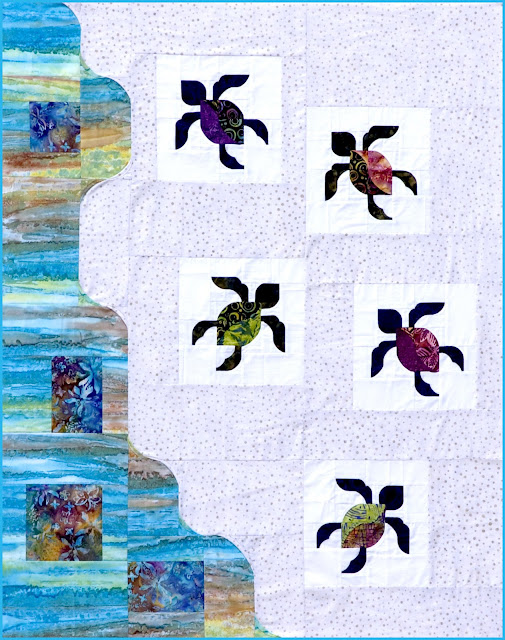My dimensional curves can be made with the smallest pieces: For example on the turtle
Tots Pattern there are several curves made from 1" folded squares and
there is a little trick to make these curves trouble free.
Use a glue-pen as shown in the picture. I also use a cardboard square to keep the glue on the little triangle only. Put just a little glue on the folded edge of the folded triangle and then place your finger in the "pocket" and lift up the folded triangle, fold it back, press and hold it in place for a few seconds to make the glue stick firmly. Repeat for all small curves.
Not all curves need to be glued. In fact, it is just as easy to smooth larger curves back while top-stitching them. A stiletto is very helpful for top-stitching any size curve, and essential for stitching small curves, when fingers are too big to hold the fold in place. Use a foot that allows visibility of the needle and always use a sharp Quilting needle to top-stitch through woven fabrics.
The hind legs of the turtles features a double curve; use a pin to separate the two parts of the curve. Pin very close to the folded edge of the triangle and weave the pin into the layers to keep it from shifting. Peel-back the first part of the curve, hold, then stitch from the corner to the pin, secure (by stitching in place), pull out the pin, peel back the next part of the double curve and continue stitching to the other side.
I hope you have fun playing with turtles and dimensional curves.
 |
Turtle Tots |
Use a glue-pen as shown in the picture. I also use a cardboard square to keep the glue on the little triangle only. Put just a little glue on the folded edge of the folded triangle and then place your finger in the "pocket" and lift up the folded triangle, fold it back, press and hold it in place for a few seconds to make the glue stick firmly. Repeat for all small curves.
 |
| Use a glue-pen to position and keep the glue just where I need it. |
 |
| Use a cardboard piece and slip it into the pocket of the small folded triangle |
 |
| Lift up the folded triangle and peel it back on itself. |
 |
| After one curve is glued back, position cardboard and glue on the next one |
 |
| Firmly press on the folded back curves to make them permanent |
 | ||||||||||
| Two small curves, perfectly formed and ready to stitch. |
Not all curves need to be glued. In fact, it is just as easy to smooth larger curves back while top-stitching them. A stiletto is very helpful for top-stitching any size curve, and essential for stitching small curves, when fingers are too big to hold the fold in place. Use a foot that allows visibility of the needle and always use a sharp Quilting needle to top-stitch through woven fabrics.
The hind legs of the turtles features a double curve; use a pin to separate the two parts of the curve. Pin very close to the folded edge of the triangle and weave the pin into the layers to keep it from shifting. Peel-back the first part of the curve, hold, then stitch from the corner to the pin, secure (by stitching in place), pull out the pin, peel back the next part of the double curve and continue stitching to the other side.
 |
| Insert pins in the center of the folded triangles, close to the fold |
 |
| Secure, then stitch from one corner to the pin, remove the pin and continue stitching |
 |
| Hind legs of turtle tot with double curve |
 | |||||||||||
| Finished Turtle Tot block, with curves. |
I hope you have fun playing with turtles and dimensional curves.


Comments
Post a Comment